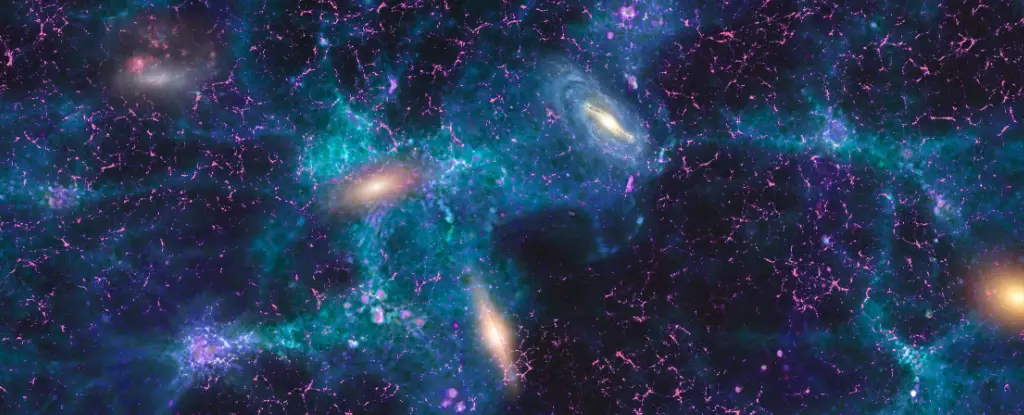In recent years, astronomers have faced a perplexing situation regarding the expansion of the universe. Despite decades of research and vast advancements in cosmological theories, the very fabric of our universe appears to be expanding at an increasingly rapid rate, one that existing physics struggles to elucidate. Recent analyses of distant galaxy clusters, starlight, and supernovae reveal discrepancies in the measurements of the Hubble constant, which describes the rate of the universe’s expansion. What was once an observation of a universal truth now emerges as a paramount puzzle, prompting critical re-evaluations of our understanding of cosmic phenomena.
At the heart of the issue lies the Hubble constant — a measure that has become a linchpin in our understanding of the cosmos. Utilizing the relationship between distance and the speed of receding galaxies, astronomers have constructed a model of an expanding universe, a breathtaking panorama of cosmic structures drifting in the vast emptiness of space. This evolving narrative has intertwined gravitational physics, quantum field theories, dark energy, and dark matter in a complex tapestry.
Historically, conflicting methodologies for determining the Hubble constant have generated debates among scientists. Two popular approaches—the distance ladder method and the analysis of the cosmic microwave background (CMB) radiation—yield vastly differing results. The expansion speed derived from local measurements suggests a more rapid cosmic growth, while ancient light signatures suggest a slower rate.
The Role of Supernovae
This discord prompted the necessity of further exploration, leading to the involvement of advanced observational tools such as the Dark Energy Spectroscopic Instrument (DESI). A recent study led by physicist Dan Scolnic and his team delved specifically into the Coma cluster, a well-known assembly of galaxies approximately 321 million light-years away. By leveraging the distinct brightness and fading patterns of Type Ia supernovae—a pivotal cosmic phenomenon resulting from the explosive death of certain stars—the researchers aimed to solidify distance measurements and consequently, the Hubble constant itself.
The precision achieved by correlating the distant supernovae data with the characteristics of galaxies in the Coma cluster provided a newfound confidence in cosmic distance measurements. The results reinforced the understanding of the rate at which space expands but also underscored the persistent divide within cosmology.
Despite achieving a robust approximation of 76.5 kilometers per second per megaparsec, concerns lingered. This speed misaligned dramatically with the 67.4 kilometers per second per megaparsec obtained through analysis of the CMB. If these findings stand unwavering, it suggests an unresolved conflict in our cosmological models, revealing inconsistencies that could potentially reshape our understanding of the universe. As Scolnic aptly expressed, this crisis drives researchers to critically examine existing theories and seek novel explanations.
Such conflicts might not merely indicate measurement errors; they point towards deeper, uncharted territories within the realm of physics. Scientists are at a pivotal juncture, where refining existing observational techniques could either unveil critical theoretical flaws or introduce revolutionary concepts regarding the universe’s fundamental architecture.
The Quest for New Physics
As cosmology evolves through scrutiny and inquiry, the distinct possibility of uncovering new physics looms large. The debate surrounding the Hubble constant represents more than just a measurement controversy; it invites a broader investigation into the nature of dark energy and dark matter. Ultimately, acceptance of these discrepancies in measurements may foster the discovery of profound truths about the universe’s origins and its accelerating expansion.
With every meticulous analysis of starlight, every calibration of observational tools, and every theoretical adjustment to existing models, scientists inch closer to untangling the cosmic web. The dynamic interplay between the measurable universe and our understanding of its underpinnings serves as a catalyst for scientific inquiry and innovation.
The ongoing cosmic conundrum underscores the challenges that modern astrophysics confronts amid great strides in technology and theoretical ingenuity. As researchers delve deeper into the intricacies of the universe’s expansion, they are met with both rigor and uncertainty. It is a captivating excursion, one driven by human curiosity and the timeless quest for knowledge.
The divergence in measurements offers an opportunity rather than a setback. It encourages a rethinking of established narratives, opens avenues for new understanding, and ignites the flame of innovation. Whether the ultimate answer reveals a flaw in current theories or suggests new physics remains to be seen, yet the adventure forward is about deeper understanding and a more profound connection to the cosmos we inhabit.

